The great public protest of recent years over Uisce Éireann would have been water off a duck’s back to Michael O’Donohoe.
His archive included a study of the supply of water to Castleisland. As far back as 1874, the public was far from content with the idea of paying for the utility.
At a board meeting of the Tralee Union in the late nineteenth century, board member P H Leahy asked by what authority a steward had been appointed to oversee the construction of the waterworks in Castleisland, a man who ‘had nothing to do but walk about with his hands in his pockets’.
Leahy stated that the people of Castleisland, who would have to pay him, ‘were strongly objecting to it’.1
.
Nineteenth Century water service
Material in the collection consists mainly of notes which follow the progress of the Dooneen Water Supply to Castleisland from 1878 to 1894 including the turning of the first-sod of the new waterworks by J K O’Connor in 1891.2
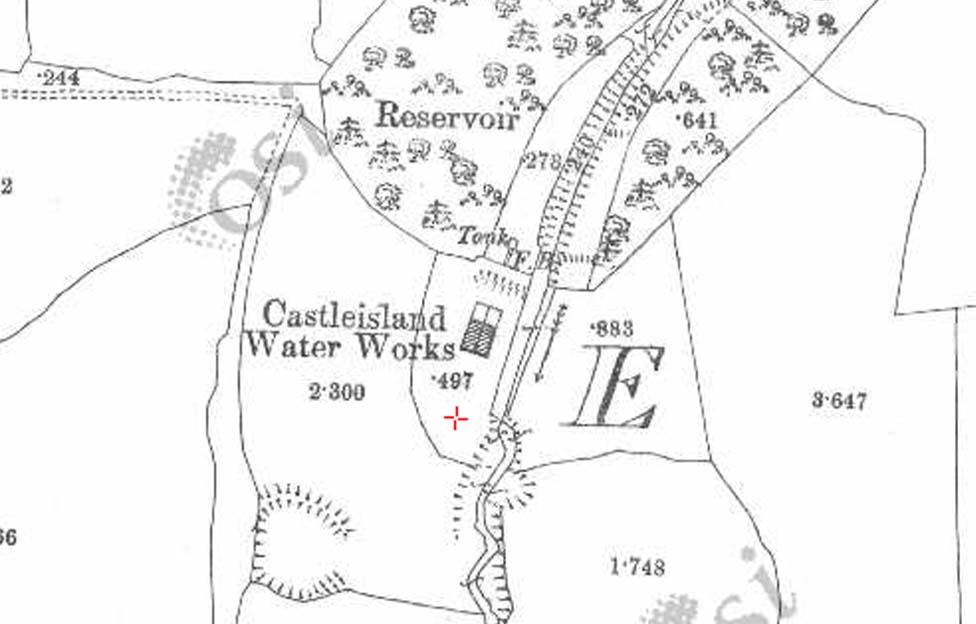
Collectively, Michael’s research conveys the development of a service taken very much for granted today.
In 1887, a compulsory purchase order was made for land at Dooneen, a townland about two miles outside Castleisland. Two years later, the project was still under discussion, of most concern the cost to the taxpayer.
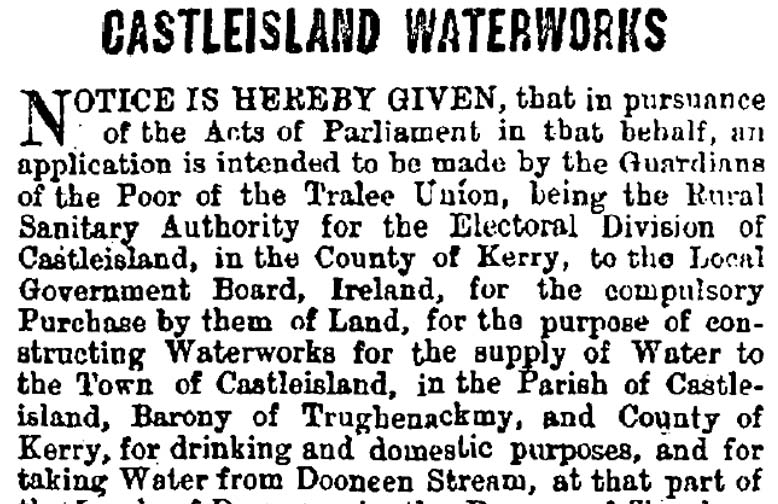
The ongoing debate revealed the toil then expended to gain a supply of water:
The townspeople had to go a quarter of a mile for water to Tubbermaing, at other times they get it from the river; they had to employ donkeys and cars to get the water … if the waterworks were constructed the convents, the police barracks, and the railway would all take water and pay for it.3
A supply of water could also be had from a well at the top of the town and a fountain, built by the Herberts of Lisheenbaun, further down.4

A local Government Board Enquiry into the state of affairs was held in 1889, John Kerry O’Connor, poor law guardian for Castleisland, explained that the single fountain supplied a population of 1500.5
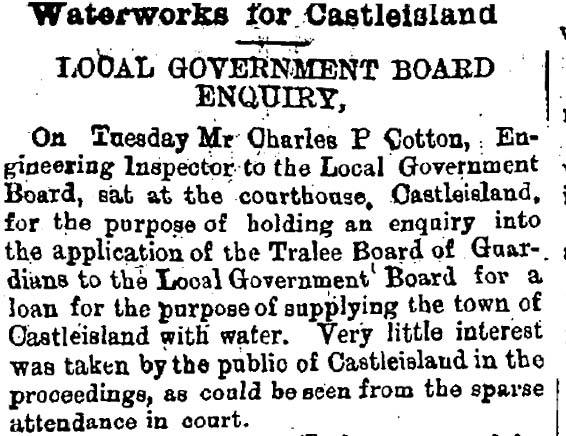
During the same proceedings, the number of fever cases in Castleisland caused by ‘bad water’ was remarked on.
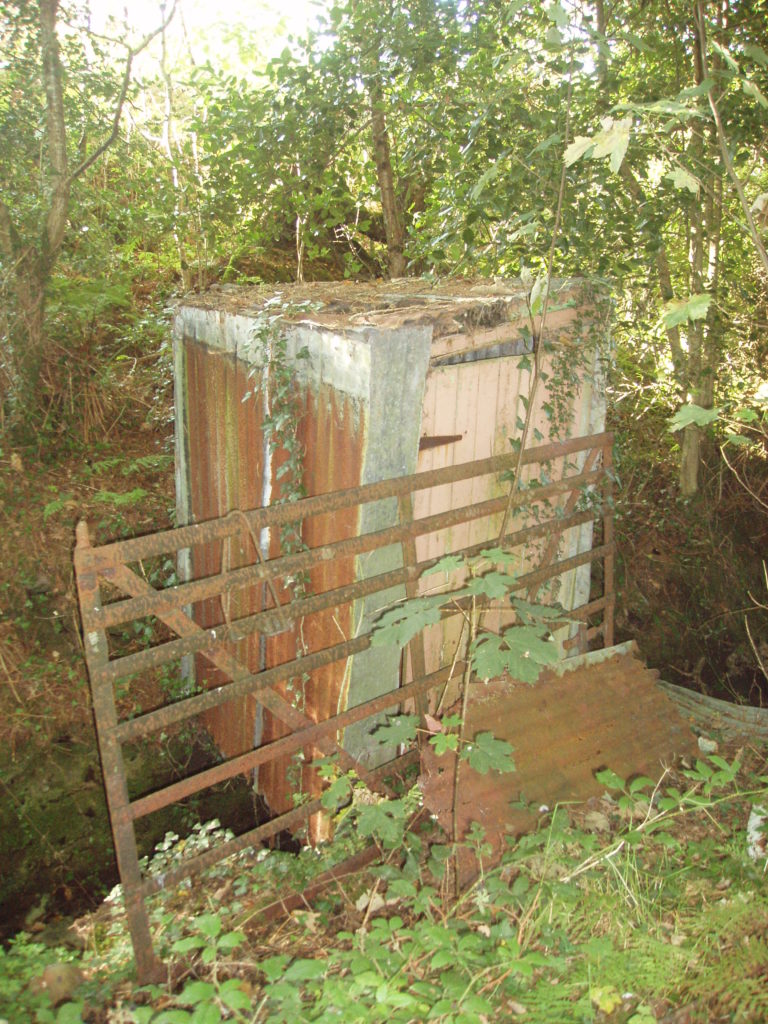
Five years later a typhoid epidemic hit Castleisland, the cause assigned to a farmhouse supplied with water from Dooneen:
Some tributaries of the Dooneen river ran through farm yards in which were deposited heaps of manure … the first patient was a farm servant in one of the houses through which the rivulet ran. From this case the disease spread.6
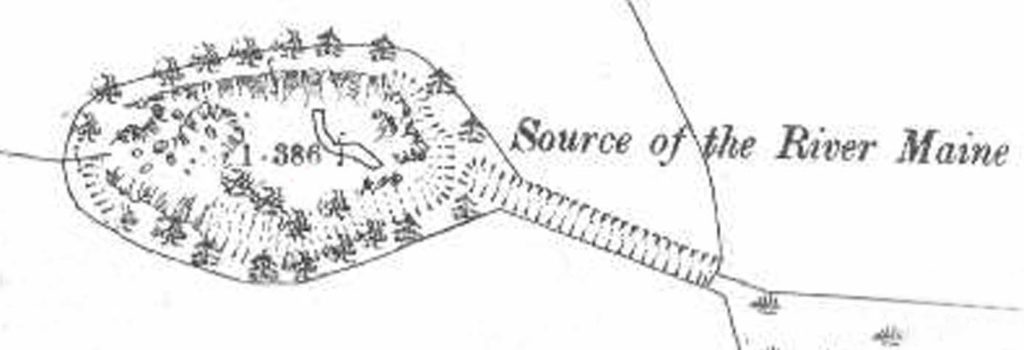
In later times, water caused controversy of a different sort in Castleisland when a townsman was fined for throwing five buckets of water over a woman. In his defence, he claimed only three buckets were thrown and that she should have walked away after the first.7
_______________________
1 Meeting of the board of the Tralee Union, see Kerry Evening Post, 19 August 1874. 2 IE MOD 22/22.1-IE MOD 22/22.1.2. Full report of turning of the first sod, IE MOD 22/22-2/22-2-9. In more recent times, the Dooneen Water Scheme to serve thirty households in Dooneen, Mullaghmarky, Glensharoon and Bawnluskaha was introduced in 1968. Report in Kerryman, 24 February 1968. 3 Kerry Weekly Reporter, 18 May 1889. Local government board enquiry into waterworks for Castleisland held at Castleisland Courthouse in May 1889. See full report of proceedings in which Dr Harold, in reply to Mr Morphy, solicitor for Lord Headley, deposed that he could not say whether there was more whiskey than water consumed at Castleisland. Morphy asked if the water was required to dilute whiskey from fifty public houses in the town. 4 Lisheenbawn (var: Lisheenbaun/Lisheenbane) of the townland of the same name. The property, of which little is known, is no longer extant. In the 1830s and '40s, it was associated with Arthur Sealy Esq. The Sealy family intermarried with the Herbert family as shown in a genealogical sketch of the 'The Sealy' to the Tralee Chronicle of 22 January 1875 (submitted by 'Henri Quarte' (Philo Henri Quatre) perhaps an anonym of John Florence Purdon McCarthy). A letter to the same medium from 'Kerriensis' (which, it may also be argued, was another disguise of McCarthy) revealed that Arthur Sealy was evicted from Lisheenbawn by Henry Arthur Herbert. Both documents are transcribed below. See biographical note on John Florence Purdon McCarthy in Series IE MOD/79. The Sealy. Name and family is of Norman extraction, en suite of William the Conqueror. The historiographers and genealogists circumambulate this name with a cloud of spellings. Cailli, Cely, or Seali, was sent to England by William the Conqueror (then Duke of Normandy), tempore Edward the Confessor, on a confidential trust. His kinsman (Le Sire de Cailli) accompanied the Duke to England in 1066. From the former of these two gentlemen descended Sir Benedict Sealy (Knight Baueret) ie a knight dubbed in the field of battle. This was in the time of Edward the Third and of Richard the Second. Sir Benedict distinguished himself on various occasions under the Black Prince – once against Hot Spur himself. Sir Benedict was beheaded in 1400 along with the Earls of Kent, Salisbury, and others. From him descended Sir William Sealy (knight) who was father of a daughter of great beauty and gifts, a Margaret Sealy, who married in the reign of Henry VIII, Ralf Maynard, ancestor of Lord Maynard. Besides that daughter (Margaret) he (Sir William Sealy) had also a son (William Sealy Esq) whose son, Edward, married Rachel Egerton, niece of the Duke of Bridgewater. They had a son (William Sealy Esq of Bridgewater in the county of Somerset). He was Mayor of Bridgewater in the 18th of James the First. He married Joan, daughter and heiress to Builleford or Belleford of South Moulton, Devon, descended from the Buillefortes of France. He died 4 Dec 1633. His son (Edward) married nobly; one of the Royal princes of England stood a spouson [sponsor?] to his son, whose name also was Edward, and was ancestor of the still existing families of Bridgewater and Exeter, and also of the Irish families of Bandon, Richmount, and Gurtnahorna, highly connected, and of high position. The second son of William of Bridgewater was Henry whose descendants were men of mark at Barbados in 1708. The third son of William Sealy of Bridgewater was (?) of Croker and Perry Court in Somerset and Devonshire. This third son's issue removed to the city of York and subsequently became proprietors of Magh, near Tralee, in the county Kerry, Ireland, and Maglass, adjacent, which came to this family jure uxoris, by an intermarriage with Alice, second daughter of Uriah Babington of Droumkeen in the county Kerry. Her husband was John or Samuel Sealy (for the record is blotted) who was son to Samuel, son of William Sealy Esq by Mildred Mullins of Dingle. It might be stated parenthetically that this Uriah Babington had four other daughters. Angel married _____ Scot Esq of Cahercon in the county Clare; Margaret married ______ Leslie Esq; Mary married William Meredith of Farnag Esq and Catherine married James Supples Esq. John, or Samuel Sealy had issue by Alice Babington two sons and a daughter. John married Agnes Chute of Chutehall, sister of Francis and aunt of Richard, commonly called 'Minor Chute; and by the people Bahr vee 'n Erin (the best man in Ireland). Uriah Sealy Esq married Mary Herbert of Currans – an estate now in the Cahernane family. Catherine married William Collis Esq and Margaret married William Wrixon Esq and after his death John Freeman, of Ballymacquin Esq. Uriah Babington Esq dying in the house of his son-in-law John or Samuel Sealy at Maglass, left an extensive testamentary document which was in the possession of his descendant, the late John Sealy Esq of Ballymalus. It was drawn up at Maglass in presence of his well-beloved friends, William Blennerhassett of Elmgrove Esq, MP, and the Rev John Day of Lohercannon, executors, Sept 29, 1756. The issue of John, of Maglass, by Agnes Chute of Chutehall were – First, Samuel, of Maglass, married Eliza Raymond of Ballylochran and they had issue John of Ballymalus, a burgher and freeholder of the city of Cork in right of descent, married and left issue Edward and Lucy. This Samuel, of Maglass, married secondly Barbara Hilliard of Listrim. Agnes married Captain John Weekes, an officer in the army and left issue. Elizabeth married Captain Quill, a Royal Navy officer, and they left issue; and Jane married John Crumpe Esq, a surgeon, who also left issue. The second son of John of Maglass by Agnes Chute, was Richard Sealy, in orders, dsp (or decessit sine prole). The third son was William, an officer in the 3rd Buffs of Knockanagore and afterwards Magh. He married his cousin, Alice, and died without issue at Magh. The fourth son of John of Maglass by Agnes Chute of Chutehall was Eusebius Sealy of Mallamaki, Castleisland who married his cousin, Sophia Sealy, and left issue one son, John Sealy of Mallamarki Esq JP. The second son of John, by Alice Babington, was Uriah Babington Sealy. He married Mary, daughter of the Rev Thomas Herbert, of Cahirnane, and they had issue, besides William, who fought in the American war as a military officer and was drowned at sea with his wife, a planter's daughter, with whom he got a fortune of 4000 acres in Nova Scotia, and Samuel of Magh who had Samuel of Magh and John of Rockfield and seven daughters. Alice, Mrs Counsellor Herbert, afterwards Mrs William Sealy of Magh; Agnes, Mrs Captain Barrett (a military man of fortune in England); Emily, Mrs Captain Shannon; Anne, Mrs Fitzmaurice; and Mary, Lucy and Catherine, died unmarried. Samuel, the elder, married Lucy, daughter of the Rev Bastable Herbert of Brewsterfield and had issue Euriah – an officer in the Royal Navy, died without issue; Bastable married Susan Shannon (his first cousin) whose only child (a daughter) died young; Arthur Herbert Fitzgerald Sealy married first Maria, relict of Doctor Ledmon, the purchaser of part of his family estate (Maglass) and secondly Kitty (Catherine), his cousin, daughter of John Sealy Esq of Rockville [?Rockfield], JP; William, proprietor of the estate of Magh (which he sold) married Deborah, daughter of the Rev William Collis of Fortwilliam who have issue, William and Lucy – Mrs Doctor Fitzmaurice – Alice, Mrs Milward of Ballyegan. John Sealy of Rockfield Esq JP was brother to Samuel of Magh. He married Anne, daughter of Raymond Fitzmaurice Esq JP and they had a numerous issue – viz, Uriah married Louisia (Miss Mason); Alice married John Barry Esq of Knockrour and had issue including the two late physicians (William and Garrett Barry Esqs). William, commonly called White William in contradiction to his cousin, Black William, married Catherine, a daughter of ___ Egar Esq by his wife (a Miss Raymond of Ballylochran). She was a sister of James R Eager Esq (founder of the Tralee Chronicle newspaper). This William Sealy won the fame or notoriety of a duelist. Cherry became Mrs Mason and left issue. John married Ellen, daughter of J Malone Esq of Rockview, Bruree, co Limerick and has issue. Agnes died unmarried. Lucy married John Hamilton Esq and they emigrated and have issue. Mary married Florence Purdon McCarthy who, through his collegiate claims from TCD had the endowed school at New Ross, &c, and they have issue. Kitty married her cousin, Arthur Herbert Fitzgerald Sealy Esq as his second wife and has issue. Emily died unmarried. Heraldry of the family. Arms – A Fesse embattled azure between three wolves' heads erased – sable. Crest – Out of a ducal coronet, or a wolf's head – sable. Motto – Concipe Spes Certas. The following is an extract from a letter to the Tralee Chronicle of 7 April 1857 by someone signing themselves 'Kerriensis' who claimed that Arthur Sealy was evicted from Lisheenbawn by Henry Arthur Herbert: 'What does it signify whether Clydane was let to a Protestant or Catholic when John Harold was so shamefully evicted? Harold resided on the land from his infancy - he survived the fearful ordeal of the famine and was thriving and comfortable when in the year '53 he was served with notice to quit and was obliged to leave. Mr Herbert's reply to him when he represented that his family had resided on the lands over 200 years, was that they had been there long enough ... I could have told you of the evictions of Maurice Roche, George Rice and Michael Eversfield from Coolnageragh, of John Barry from Bawnaskehy, of Arthur Sealy from Lisheenbawn, of John Ahern and John Leahy from Ballynahally, of Richard McCarthy from Clydane and of hosts of others which sent some of them to seek that livelihood in a foreign land that was denied them at home and more to a premature grave. I could have told you of the wholesale depopulation at Carrigees, at Brosna, and at Scartaglin, the facts of which are as notorious as that his tenants are possessed of as little real liberty and are as slavishly servile as the serfs of Siberia or the negroes of Carolina - that his leases are shams, and their holders as dependent on his mercy as if they never had existence, that leases are withheld from the tenants on his tenements in Castleisland because they do not effect policies of fire insurance on the houses in Mr Herbert's name and themselves pay the premiums and all the other acts of fostering care emanating from him and his underlings ...'. 5 Kerry Weekly Reporter, 18 May 1889. O'Connor calculated there were about 20 toilets in the town with no means of flushing them, 'those 20 water closets had to do 1500 people; that would be 75 people to a water closet'. 6 Sixty-eight cases of fever were recorded; residents of Castleisland were advised to boil water before use. Full report Kerry Evening Post, 28 February 1894. 7 'I only threw three buckets on her and not five ... if she was all this lady she would have walked away after the first bucket and not waited for the others' (Kerryman, 29 September 1962). Old image of fountain, see irishancestorsdirect.com.


